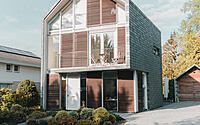Choosing a Home Design That Suits the Land Size
There are many factors to consider regarding the design of your home once you’ve decided to build a new home and have found the ideal piece of land. There are numerous home design options, and finding the one that would perfectly fit your piece of land and home requirements may seem difficult.
To help you narrow down your options, here are some fantastic questions that can nudge you in the right direction.
What’s the Size of Land?
The exact size of your home will depend on the size of your lot. There’s a big difference between owning 10 acres of land or property of just over 2,500 square feet. Wondering how big is an acre? An acre equals 43,560 square feet, and the most common shape for an acre is 660 feet by 66 feet. That being said, the average house for a single family is 2,400 square feet. So, depending on how many acres of land you own, there will be different home design options.
For instance, if you have a real estate property of several acres, you can create an open-plan living space to maximize indoor/outdoor living and have ample yard space the whole family will enjoy and room to install a pool later. However, if the plot of land is less than a single acre, you might need to sacrifice outside space to guarantee that your home fulfills all of your wants and fits your lifestyle.
What Would Be the Ideal Orientation of the Home?
The location of your property is another key factor to consider when choosing a home design. To take advantage of the afternoon sun and provide your open-plan areas with plenty of natural light, the living areas should be north-facing.
If you have an outside space, try to place it where it will get afternoon and evening sun, so it’s in the ideal location for entertaining. Bedrooms should face east so you can wake up to the first light of the day. This will help keep the rooms cool throughout the warmer months by keeping them out of the hot afternoon sun.
Is the Land Sloping?
One of the biggest factors to consider when planning to construct a piece of land that slopes are how the land falls. You can enter your home at ground level if you plan your home so that the bedrooms and garage are located on the flat portion of the property, and the living spaces and kitchen can be placed higher up on the slope to make use of the views. The slope of the parcel of land will also influence whether you need to dig into the soil to make a more level surface for building on or whether your home may be elevated by using stilts.
How to Achieve Privacy?
Making your home feel safe and private while maintaining a connection to the outside environment is crucial. It’s not always necessary to utilize walls and opaque glass to provide privacy. Depending on the land’s position and its surroundings, it’s possible to place door and window openings in the home to prevent passersby and neighbors from seeing inside. By doing this, your house can defend itself from overlooking while maximizing its outlook.
What Is the Location Offering?
When choosing a house design, you want to take most of the advantages of your surroundings. For example, you might opt to construct a split-level home with a reverse living arrangement if you live close to bodies of water. That way, you’ll be able to fully enjoy the sea breeze every day from the main living areas located upstairs.
Similarly, having the main living rooms upstairs will provide you with the best views of the rolling hills if your property is in a rural area with lots of open space. On the other hand, you might not need to build up to enjoy the stunning views if you reside on a large, clear plot of land. You can have a one-story house with a huge backyard space surrounded by nature.
Final Thoughts
The first exciting step in your home-building journey is choosing the ideal piece of property to build on. Once you find the plot where you can turn your dream house into reality, gather information about the exact acreage, property lines, and the actual acreage on which you’re permitted to build. It will be challenging to visualize what you want and need when choosing a home design, so make sure you consider every aspect of the land and make an informed choice.
- by Matt Watts






